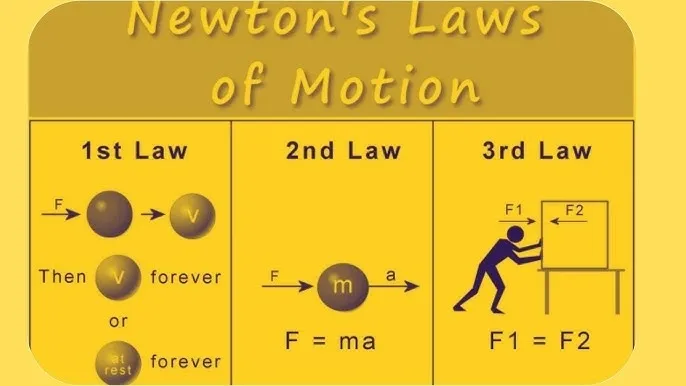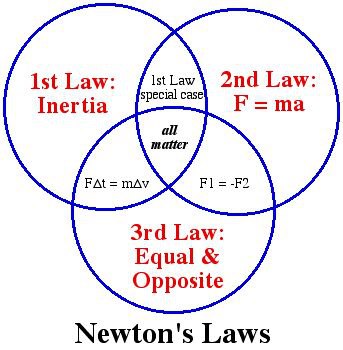Newton's Laws: The Foundation of Motion and Modern Innovation...!!!
Newton's laws of motion are fundamental to our understanding of how objects move and interact. They have extensive implications and applications in various fields, from transportation and sports to space exploration and everyday activities. By understanding and applying these laws, we can better predict and control the motion of objects, leading to advancements in technology, engineering, and science.

Newton's laws of motion are essential principles in classical mechanics, providing the foundation for understanding how objects move and interact. Formulated by Sir Isaac Newton in the 17th century, these three laws have become integral to the study of physics.
Newton's First Law of Motion (Law of Inertia)
Statement:
Newton's First Law of Motion, also known as the law of inertia, states that an object will remain at rest or in uniform motion in a straight line unless acted upon by an external force.
Implications:
-
Inertia: This concept refers to an object's tendency to resist changes in its state of motion. An object at rest stays at rest, and an object in motion continues moving unless influenced by an external force.
-
Equilibrium: An object is in equilibrium when the net force acting on it is zero, meaning it will either remain at rest or move at a constant velocity.
Applications:
-
Automotive Safety: Seatbelts and airbags in vehicles are designed with inertia in mind. They help counteract the inertia of passengers during sudden stops or collisions, reducing injury risks.
-
Spacecraft Navigation: In space, where friction is minimal, spacecraft rely on their inertia to travel vast distances. Thrusters apply external forces to change the spacecraft's direction or speed.
-
Sports: In sports, understanding inertia is crucial. For instance, a soccer player must apply a force to change the state of a stationary ball, and a skier glides down a slope due to minimal external forces affecting their uniform motion.
Newton's Second Law of Motion (Law of Acceleration)
Statement:
Newton's Second Law of Motion states that the acceleration of an object is directly proportional to the net force acting on it and inversely proportional to its mass. Mathematically, it is expressed as F = ma, where F is the net force, m is the mass, and a is the acceleration.
Implications:
-
Force and Acceleration: A greater force applied to an object results in greater acceleration. Conversely, for a given force, a more massive object will experience smaller acceleration.
-
Measurement of Force: This law provides a quantitative measure of force, linking it directly to an object's mass and acceleration.
Applications:
-
Engineering: Engineers use this law to design structures and machines that can withstand specific forces. For example, calculating the forces on a bridge ensures it can support vehicles and withstand environmental forces like wind.
-
Aerospace: This law is fundamental in rocket propulsion. The thrust generated by a rocket's engines determines its acceleration, allowing scientists to calculate the necessary force for the desired trajectory.
-
Sports Physics: In sports like basketball, players apply varying forces to achieve the desired acceleration and speed when passing, shooting, or dribbling the ball.
Newton's Third Law of Motion (Action and Reaction)
Statement:
Newton's Third Law of Motion states that for every action, there is an equal and opposite reaction. In other words, if an object exerts a force on another object, the second object exerts an equal and opposite force on the first object.
Implications:
-
Interaction Pairs: Forces always occur in pairs, known as action-reaction pairs. These forces are equal in magnitude but opposite in direction.
-
Conservation of Momentum: This law is closely related to the conservation of momentum, which states that the total momentum of a closed system remains constant if no external forces act on it.
Applications:
-
Propulsion Systems: This law explains the principle of rocket propulsion. As a rocket expels gas backward (action), the rocket itself is propelled forward (reaction).
-
Walking and Running: When we walk or run, our feet push against the ground (action), and the ground pushes back with an equal and opposite force (reaction), propelling us forward.
-
Swimming: Swimmers push against the water with their hands and feet (action), and the water pushes back with an equal and opposite force (reaction), allowing them to move through the water.
Real-World Applications and Examples
Transportation:
-
Cars and Trucks: Newton's laws are used to design vehicles, ensuring they accelerate, decelerate, and maneuver safely. Engineers calculate the forces required for efficient braking systems and understand collision impacts.
-
Aircraft: The principles of lift, thrust, drag, and weight in aviation are based on Newton's laws. Understanding these forces is essential for designing stable and efficient aircraft.
Sports:

-
Baseball: When a player hits a baseball, Newton's laws explain the ball's motion. The force applied by the bat (action) results in the ball's acceleration and trajectory (reaction).
-
Tennis: The force exerted by a tennis racket on the ball determines the ball's speed and direction. Players adjust their force to control the ball's movement.
Everyday Activities:
-
Opening Doors: Pushing or pulling a door involves applying a force (action), and the door moves in response (reaction).
-
Bouncing Balls: When a ball hits the ground, it exerts a force on the ground (action), and the ground exerts an equal and opposite force, causing the ball to bounce back (reaction).
Space Exploration:
-
Satellite Orbits: Satellites in orbit rely on the balance between gravitational force and inertia. Understanding these forces allows scientists to calculate and maintain stable orbits.
-
Spacewalks: Astronauts use tethers and thrusters to maneuver in space. The principles of action and reaction are crucial for their movement and safety.
Newton's laws of motion are fundamental to our understanding of how objects move and interact. They have extensive implications and applications in various fields, from transportation and sports to space exploration and everyday activities. By understanding and applying these laws, we can better predict and control the motion of objects, leading to advancements in technology, engineering, and science.
What's Your Reaction?

















